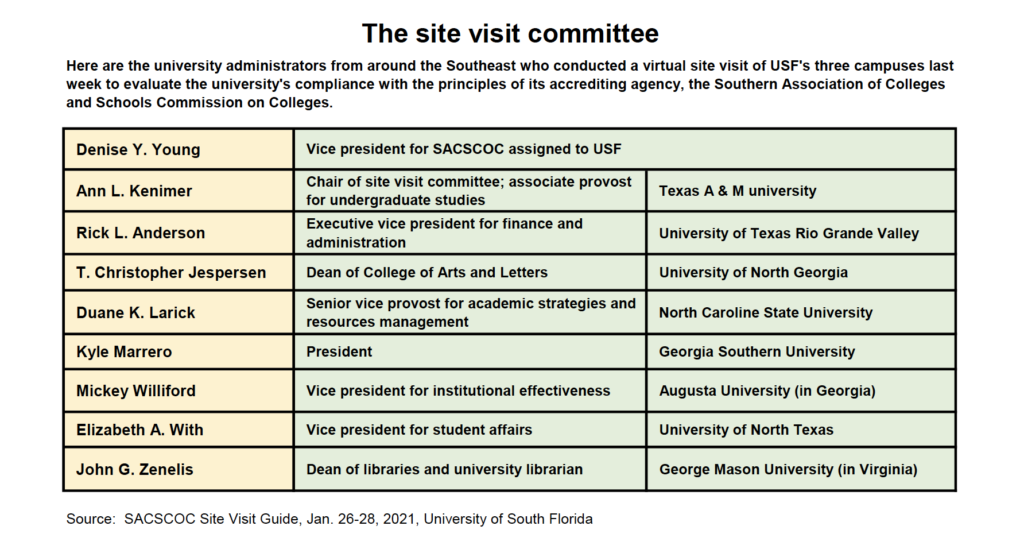Pictured Above: Professor David Rosengrant (left), chair of St. Petersburg’s Faculty Council, said the campus was well represented during a virtual site visit by the regional accrediting agency. The visiting committee was led by Ann L. Kenimer, the associate provost for undergraduate studies at Texas A&M University.
Courtesy of David Rosengrant and Texas A&M University
By Nancy McCann
The University of South Florida had a six-month checkup on consolidation last week.
The Southern Association of Colleges and Schools Commission on Colleges (SACSCOC) held a two–day virtual site visit to evaluate USF’s compliance with the agency’s accreditation principles.
Now that the Tampa, St. Petersburg and Sarasota-Manatee campuses are operating under a single accreditation – which took effect last July 1 – the regional accrediting agency must assess how well the consolidation plan it approved last June is meeting accreditation requirements.
The accreditation principals stem from the agency’s six core values: “Integrity, continuous quality improvement, peer review/self regulation, accountability, student learning, and transparency.”
David Rosengrant, chair of St. Petersburg’s Faculty Council, said he thought “our campus was well represented” during the site visit.
“I was personally involved with three separate meetings . . . one of those meetings was specific to our campus,” Rosengrant,an education professor, wrote in an email to The Crow’s Nest.
When asked if the meeting atmosphere encouraged the free sharing of problems and challenges in consolidation, he responded positively about the sessions he attended.
“Yes, the meetings were conversational. Some of the site visit members that we had the conversations with had gone through consolidations themselves so they were familiar with what we were going through,” Rosengrant said. “Personally, I never felt like I had a big brother looking over my shoulder.”
He said challenges related to “skirmishes” about university-wide general education requirements that were eventually resolved and “initial feelings of not being included” in consolidation planning were discussed with the visiting SACSCOC team.
Faculty, administrators and students who received invitations met with SACSCOC representatives on topics like academic affairs, student success, libraries, budget and finance, and institutional planning and effectiveness.
A list of instructions for the university’s participants in the site visit guide on the university’s website included “focus on the positive attributes of the University across all campuses” and everyone “must contribute” but not “dominate conversation.”
The schedule provided to The Crow’s Nest by the university shows President Steve Currall and Board of Trustees member John Ramil having meetings of their own with three members of the SACSCOC site visit team. See the committee’s full schedule below.
The steady stream of meetings, most of them scheduled for about 30 minutes, included one to 15 university participants and from one to all nine of the SACSCOC committee members.
The two branch campuses had breakout sessions, including virtual campus tours. St. Petersburg’s representatives included six students and eight teaching faculty, who met in their own groups with members of the site visit committee.
Other breakout sessions were scheduled for Regional Chancellor Martin Tadlock and several St. Petersburg administrators. Tadlock had no solo sessions scheduled with the SACSCOC team.
Tadlock said he met with members of the team twice.
“One meeting was to give a virtual campus tour, which I led,” he said. “The other was as a member of the campus leadership team.”
Tadlock said he was not asked any direct questions by the SACSCOC team, “although I could have commented during both meetings when questions were asked.”
The chair of the SACSCOC committee that visited USF is Ann L. Kenimer, associate provost for undergraduate studies at Texas A & M University. Also on the committee is Denise Y. Young, the vice president at SACSCOC who is assigned to USF. (See list of committee members below)

Source: SACSCOC Site Visit Guide, Jan. 26-28, 2021, University of South Florida
Having completed the site visit, the SACSCOC visitors will submit a report to the accrediting agency. USF will have five months to respond to observations in the report, according to information on USF’s website.
The SACSCOC Board of Trustees, after reviewing the report and any responses from USF, will take action in June or December.
The possible outcomes are: continue the new single accreditation; “impose sanctions” if USF fails to meet the agency’s accreditation principles; or “recommend that the branch campuses seek separate accreditation if SACSCOC determines that the branch campuses” are not sufficiently controlled by the Tampa campus.
Schedule of the accrediting agency’s site visit committee



